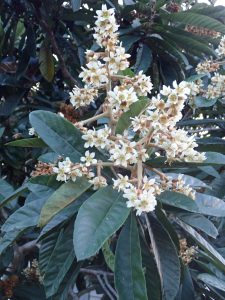A Loquat tree is a must-have for every Florida edible landscape. This gorgeous evergreen tree is also low-maintenance compared to other fruit trees. Fruit from any Loquat is edible, but for good-tasting, high quality fruit, select a variety of Japanese Loquat (Eriobotrya japonica) that is bred for its edible fruit. Loquat varieties have a wide range of flavors, fruit sizes, and skin thickness, so research locally available varieties for characteristics that suit you. Loquat should not be confused with Kumquat, a fruiting tree in the citrus family.
Loquat fruit is high in vitamin A and contains carotenoid antioxidants, which boost your immune system, and phenolic compounds that can reduce inflammation and help safeguard against conditions like diabetes and heart disease. Loquat fruits are even being studied for their anti-cancer properties.
Loquat is native to China and grown commercially throughout the subtropical and Mediterranean regions of the world in countries like Japan, India, and Turkey. While Loquat is a common landscape plant in Florida, it isn’t a popular commercial fruit crop and you aren’t likely to find them at grocery stores. There is a Florida Loquat Festival though!
If you want to grow your own Loquats, start by selecting a sunny location in your landscape that has very good drainage, as Loquat trees cannot tolerate wet soils or flooding. Plant a tree as if it is already full grown so it has enough room to grow. This tree will look best if allowed to grow to its mature size of about 25 ft. tall by 15 ft. wide, however, it can be maintained as a shorter tree to make fruit harvest easier.
You can find Loquat trees at local edible nurseries. Many specialty edible varieties of Loquats from nurseries are grafted trees and will begin fruiting about a year after planting. Loquat trees grow easily from seed, but will take up to eight years to begin fruiting, and will not always produce the same type of fruit that they came from.
Loquat blooms in December in Central Florida. Loquat trees are very cold tolerant, but blooms or developing fruit can be damaged by frosts or temperatures below 30°F. Loquat flowers are pollinated by insects like bees, flies and butterflies. Protect pollinators by limiting pesticide use in the landscape, especially when plants are in bloom. Most Loquats will fruit without other Loquats around, but will have larger, more abundant fruit if there is different variety of Loquat nearby.
pollinated by insects like bees, flies and butterflies. Protect pollinators by limiting pesticide use in the landscape, especially when plants are in bloom. Most Loquats will fruit without other Loquats around, but will have larger, more abundant fruit if there is different variety of Loquat nearby.
Apply low-nitrogen fertilizer lightly several times per year. High nitrogen fertilizers, including lawn fertilizers, can reduce flowering and promote fire blight disease in loquat.
Thinning fruit by leaving only 4-10 fruits per cluster will increase fruit size significantly. Loquat fruit is often eaten by birds and can be infested by Caribbean fruit fly larvae. You can protect fruit by tying paper lunch bags over each cluster of small, unripe fruits. Bagging also hastens fruit development and reduces fruit scarring.
Fruit is harvested in the spring here. Since fruit color depends on variety, tasting fruit is the best way to know if it’s ripe and ready to harvest. Cut clusters of fruit from branches and then clip individual fruit from the cluster. Ripe loquat fruit may be stored in plastic bags in the refrigerator for several weeks. Loquat may be eaten fresh, with or without the peel, or made into pie, sauces, jam, syrup or wine. Fruit may also be canned, dried, or frozen for use later.
For gardening, farming and food classes and information, or finding plant sources, contact the UF IFAS Extension-Osceola County: 321-697-3000, or your local Extension office. Fact sheet on growing Loquat in Florida.
Source: UF/IFAS Pest Alert



